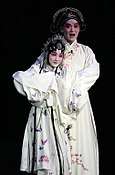The Peony Pavilion
The Peony Pavilion (Chinese: 牡丹亭; pinyin: Mǔdān tíng; Wade–Giles: Mu-tan t'ing), also named The Return of Soul at the Peony Pavilion, is a romantic tragicomedy play written by dramatist Tang Xianzu in 1598, and the plot was drawn from the short story Du Liniang Revives For Love. It depicts a love story between Du Liniang and Liu Mengmei that overcomes all difficulties, transcending time and space, life and death; the pair unite at the end. Tang's play diverges from the short story in that it dynamically integrates the legendary and the reality in Ming Dynasty. Scenes of love in dreams, Du Liniang's revival, or any supernatural element seem absurd in play, but it reflects the sprout of humanism, through protagonists' strong desire and unremitting pursuit of free love, and uncovers the degeneracy of the society under feudalism at that time.
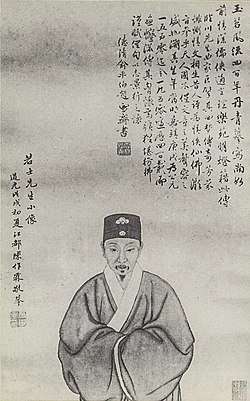
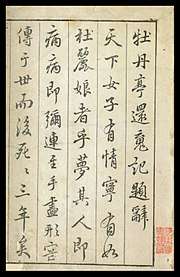
The play was originally written for staging as Kunqu opera, one of genres of traditional Chinese theatre arts. It was first performed in 1598 at the Pavilion of Prince Teng. With its sophisticated plot, magnificent dramatic structure and well-depicted characters, The Peony Pavilion has become the most popular play from the Ming dynasty and Du Liniang became one of the most representative women in ancient Chinese drama. Most audience and contemporary critics have a high estimation of the play. It has become one of the most classic in traditional Chinese theatre art, and Kun theatre troupes can not consider their repertoire complete without this play.
Tang Xianzu was one of the greatest dramatists and writers in Ming Dynasty, and The Peony Pavilion can be regarded as his most successful masterpiece in his life. It is also one of drama in Tang's famous collection Linchuan si meng (The Four Dreams in the Jade Tea Hall), the other three plays are Zichai Ji (The Purple Hairpin), Nanke Ji (A Dream Under the Southern Bough) and Handan Ji (The Handan Dream). Both the play and its dramatist get a high reputation on Chinese and international stages, and the study on Tang Xianzu has become a popular subject today.
The play has a total of 55 scenes,[1] which can run for more than 22 hours onstage.[2]
Synopsis
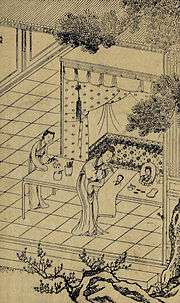
The performance onstage traditionally focuses on the love scene between Du Liniang and Liu Mengmei, but its original text also contains subplots pertaining to the falling Song Dynasty's defense against the aggression of the Jin Dynasty. The story is set in the last days of the Southern Song Dynasty. On a fine spring day, her maid persuades Miss Du Liniang, the sixteen-year-old daughter of an important official, Du Bao, to take a stroll in the garden, where she falls asleep. In Miss Du's dream, she encounters a young scholar (identified later in the play as Liu Mengmei, whom in real life she has never met). Liu Mengmei's bold advances ignite a passionate romance between the two lovers and it flourishes rapidly. Du Liniang's dream is interrupted by a flower petal falling on her (according to her soliloquy in a later act, "Retracting the Dream"). Du Liniang can not seem to get the oneiric love affair out of her mind, and her lovesickness quickly consumes her. Unable to recover from her fixation, Du Liniang wastes away and dies.
The president of the underworld adjudicates that marriage between Du Liniang and Liu Mengmei is predestined and Du Liniang ought to return to the earthly world. Du Liniang then appears to Liu Mengmei in his dreams who now inhabits the garden where Du Liniang had her fateful dream. Recognising Du Bao's deceased daughter to be the girl who turns up in his dreams, Liu agrees to exhume her body upon her request and this is how Du Liniang is brought back to life. Liu visits Du Bao and informs him of his daughter's resurrection. The disbelieving and furious Du Bao threw Liu into prison for being a grave robber and an impostor.
The ending of the story follows the formula of many Chinese comedies. Liu Mengmei narrowly escapes death by torture thanks to the arrival of the results of the imperial examination in which Liu has topped the list. The emperor pardons all.
In the first scene, there is a four-sentence introductory speech succinctly summarizing the main storyline:
"Du Liniang draws a portrait true to life;
Chen Zuiliang brings about the peace once more;
Liu Mengmei meets his resurrected wife;
Du Bao gives tortures to his son-in-law."
Scenes
There are total of fifty-five scenes in the play.
(This is the version translated by Zhang Guangqian.[3] Scenes in boldface are those usually adopted/performed onstage.)
|
1. The Prologue 4. The Pedant's Complaint 7. The Family School 10. A Surprising Dream 13. Setting Out 16. An Inquiry 19. A Female Bandit 22. En Route 25. Recalling the Daughter 28. Secret Rendezvous 31. War Preparations 34. The Prescription 37. The Shocked Pedant 40. The Humpback Espier 43. Defending Huai'an 46. Outwitting the Bandits 49. Lodging by River Huai 52. Searching for the Zhuangyuan 55. A Decreed Reunion |
2. Ambitious Thoughts 5. Engaging a Tutor 8. Supervising Agriculture 11. King Warning 14. Drawing a Self-portrait 17. The Taoist Nun 20. Untimely Death 23. The Nether Judge 26. Admiring the Portrait 29. Suspicious Aroused 32. A Vow 35. Resurrection 38. Planning an Attack 41. Delayed for the Examination 44. Filial Concern 47. The End of the Siege 50. An Uninvited Guest 53. Under Torture |
3. Disciplining the Daughter 6. A Dismal View 9. Clearing the Garden 12. Retracing the Dream 15. Invaders 18. The Diagnoses 21. Meeting the Envoy 24. Discovering the Portrait 27. The Wandering Soul 30. Interrupting the Amour 33. Confiding the Scheme 36. Abscondence of the Newlyweds 39. Reaching Lin'an 42. Transferring on Huai'an 45. The Two Defrauders 48. A Reunion with the Mother 51. The Proclamation of the Results 54. The Happy Tidings |
|
Characters
There are about 160 odd characters in the play and 30 of main characters are vividly represented,[4] especially:
- Du Liniang is a sixteen-year-old young lady, daughter of Du Bao. The play's female protagonist.
- Liu Mengmei is a young scholar, Du Liniang's lover. The play's male protagonist.
- Du Bao is a court official, father of Du Liniang.
- Chunxiang is a maid to Du Liniang.
- Chen Zuiliang is a Confucian follower, who failed imperial examinations for fifteen times in his life, and later became Du Liniang's tutor.
- Sister Stone is the pivotal role in Du Liniang's revival and facilitates this young couple's happy union in the end.
Interpretation and criticism
Script and its staging
Albeit conventional in its narrative structure, notably its deus ex machina ending, The Peony Pavilion is hailed as one of the high points of Chinese literature because of the highly refined and subtle lyrics that it features. Accentuated by the then newly developed Kun music, the lyrical prose of the play patiently weave a fabric of nuances and metaphors that elegantly transgresses the apparent divide between nature's beauty and man's inner cosmos of emotions and desires. Through the lights and shadows of this lyrical fabric transpire ravishing delicacy and intoxicating effeteness and yet, almost antithetically, a persistent undercurrent of youthful optimism. The magic of the play's prose embedded in Kunqu quickly carries the audience to a unique experience of a literary and musical banquet of metaphors, a dance of the imagination and, above all, a celebration of sensitivity. For this reason the Peony Pavilion sets the measure for all later Kun operas.
From 1598 until 1616, the year Tang passed away, the Peony Pavilion was always performed with whole scenes onstage. But later, more and more adaptions focusing on several scenes were adopted onstage rather than with a complete one, since it would cost large number of expend/ energy and time to run the whole play. "A walk in the Garden" (遊園/游园) and "The Interruption of a Dream(驚夢/惊梦)", these two acts actually originating from one scene, namely "A Surprising Dream" in the original text, and "Reflection On the Lost Dream" (尋夢/寻梦), are generally considered as the apogee of Kunqu in term of their literary achievements as well as for their musicality, choreography and the integration of all components. Due to the unique of its lyrics, rhythm, ancient style prose written, the translation became a daunting challenge for literature scholars and theatre practitioners.
Besides, recent adaptations have sought to inject new life, such as more accessible scripts for modern audience, new choreography or new theatrical technologies, into one of China's best-loved classical play, but since such efforts have met with opposition from the Kun opera traditionalists, to a certain degree, some scholars seriously critique them. To keep its traditions or to make it modernized has become a controversial conversation in Chinese theatre.
Humanism
The play was widely acclaimed by the public and critics when it was first presented onstage, and it is also regarded as the Chinese version of "Romeo and Juliet". Through narrating a tortuous love story, Tang portrays an image of a young couple with a strong desire for democratic thoughts and individual emancipation, which evoked most audience empathy, especially women audiences, and regarded Du Liniang as their idol for free love. Subject/ theme on "uncovering social darkness and caring people sufferings", "qualities of heroism", attacking feudalism and marriage system", "exposing the miserable fate of women" and "reflecting family and social ethics", etc., are generally discussed in ancient Chinese drama, which is also evident in The Peony Pavilion.
About "Dream"
Some people also raise an idea that Tang's works of "The Four Dreams" is somehow resemble Freud's interpretation of dreams. From the perspectives of psychoanalysis, the action of "A walk in the Garden" is the awakening of Du Liniang's suppressed urges and unacknowledged emotions, while the scene of "A Surprising Dream" is exactly her fantasy of sexual satisfaction.
Performance productions
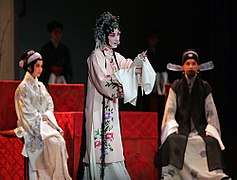
- In 2012, an outdoor production of Metropolitan Museum galleries presented The Peony Pavilion in a compact seventy-minute version developed and directed by celebrated composer Tan Dun with choreography by Huang Doudou, one of China's most prominent dancers, in the Met's Astor Court, the courtyard modeled on a seventeenth-century garden. This production is available on demand on the Metropolitan Museum's website.[5]
- In 2012, the China Arts & Entertainment Group, a creative enterprise under the administration of the Ministry of Culture for the People's Republic of China, announced the United States premiere of a new dance drama production of The Peony Pavilion by China Jinling Dance Company of Nanjing would be performed at the David H. Koch Theater, Lincoln Center, for four performances in early January.
- In June 2008, the Suzhou Kunqu Opera company performed The Peony Pavilion at Sadler's Wells, London, the UK premiere. It was presented in 3 parts on consecutive evenings, each lasting 3 hours, though still much shorter than the original 20 hours.[6]
- In May 2008, the National Ballet of China premièred a two-scene ballet adaptation of The Peony Pavilion in Beijing. This production was rewritten and directed by Li Liuyi, choreographed by Fei Bo, and the music was composed by Guo Wenjing. It also attended Lincoln Center Festival in 2008, at David H. Koch Theater, and Edinburgh International Festival in August 2011.[7]
- The Imperial Granary's production The Peony Pavilion in Beijing, directed by Kunqu Opera master Wang Shiyu and scenography by the renowned Lin Zhaohua, was a permanent residency show for about 5 years since the premiere in 2007.
- In 2004, Pai Hsien-yung's youth edition of The Peony Pavilion aims to rejuvenate the traditional staging. Pai, a Chinese scholar at the University of California, Santa Barbara, and his colleagues - scholars and performers, some brought back from retirement - spent five months editing Tang's script. Working out of the Jiangsu Suzhou Kunqu Theater, the group condensed and adapted the original fifty-five scenes to twenty-seven scenes, and twenty hours of performance time to nine. Bai, who had chosen The Peony Pavilion because of its universal message of love, hoped that his rendition would attract youth to Kunqu. In fact, in its tour of China's top universities, the show was marketed as the Youth Edition of Peony Pavilion.[8] (The production also toured in Taipei, Hong Kong, Macau, seven cities in mainland China, and the Zellerbach Theater in Berkeley, California.) According to Bai, the goal of this youth-oriented production was to "give new life to the art form, cultivate a new generation of Kunqu aficionados, and offer respect to playwright Tang and all the master artists that came before."[9] His production of The Peony Pavilion was his way of doing so. Pai Hsien-yung has also used The Peony Pavilion as inspiration for a short story and a television script.
- Recent adaptations of The Peony Pavilion and allusions in popular music have revived interest in Kunqu, an art form that had been in danger of disappearing into obscurity. In 2001, UNESCO proclaimed Kunqu as a "Masterpiece of the Oral and Intangible Heritage of Humanity," yet the secrets of that heritage were kept by only a few aging masters in even fewer schools and institutions.
- In 1999, Lincoln Center for the Performing Arts produced a 20-hour version of The Peony Pavilion, directed by Chen and starring Qian Yi as Du Liniang. This 20-hour version was perhaps the first full-length staging in 300 years. Lincoln Center's version toured extensively, including New York, Paris, Milan, Singapore, Caen, Charleston, Aarhus, Berlin, Perth and Vienna.[10]
- In 1998, an experimental or “avant-garde” production of The Peony Pavilion composed by Tan Dun, directed by Peter Sellars and performed by Kun Opera Troupe, premiered in Vienna, and travelled to London, Roma, Paris, and Berkeley later. Also, a CD recording of this opera was released entitled "Bitter Love".
Famous performers
- Mei Lanfang, sometimes paired with Yu Zhenfei (俞振飛/俞振飞) as Liu Mengmei, was famous for his sensitive portrayal of Du Liniang.
- The most famous actress of recent years is likely Zhang Jiqing's (張繼靑/张继青) traditional approach out of Nanjing's Jiangsu Province Kun Opera.
- In Shanghai, Jennifer Hua Wenyi (華文漪/华文漪) was very popular in the role, and has played the role abroad several times.
- For a particularly pleasant and graceful interpretation, one may refer to Zhang Zhihong (張志紅)'s performances in the 1990s.
Translation
- The earliest western version of The Peony Pavilion is in German - An selected translation of and an introduction to The Peony Pavilion, which published in an article China' s Love Stories, written by Xu Daolin (Hsu Dau-lin) in 1929.[11]
- A complete German translation of The Peony Pavilion, translated by Vincenz Hundhausen, was published by Lacherre Publishing House in Zurich and Leipzig in 1937.[12]
- A France translation of the scene "A Surprising Dream" was contained in An Anthology of Chinese Poems and Essays, published by the Delagraphe Publishing House in 1933.
- A latest complete French translation of The Peony Pavilion, translated by Andre Levy, was published in 2000.
- A selected translation in Russian by L. N. Menshkov in Oriental Classic Drama: India, China and Japan in 1976.
- Main complete translations in English:
- The Peony Pavilion, translated by Cyril Birch, first published by Indiana University Press in 1980
- The Peony Pavilion, translated by Zhang Guangqian, first published by Tourism Education Press in 1994.
- The Peony Pavilion, translated by Wang Rongpei, first published by Shanghai Foreign Language Education Press in 2000.
- The Peony Pavilion, translated by Xiaoping Yen, Dumont: Homa & Sekey Books, 2000.
Others adaptions
Pop music
- Leehom Wang, the popular Taiwanese-American music artist, referenced The Peony Pavilion in his song "Beside the Plum Blossoms" (在梅邊) on his album Heroes of Earth, which drew heavily from Beijing Opera and Kunqu inspiration.[13] Lee-Hom sang and rapped over traditional Kunqu melodies blended with hip-hop beats. The music video features the artist, in modern clothes, superimposed on animated scenes. The animation depicts thematic and stylistic elements of The Peony Pavilion as well as hip-hop imagery: a break dancer does tricks atop a pavilion and pink peonies turn into speakers. A performer dressed in Kunqu costume plays the role of Liu in the music video, often singing with the Kunqu technique next to Lee-Hom. The artist quotes lines from The Peony Pavilion and entreats his lover, "Let me love you…in the classical style."[14] The lyrics reveal a longing to return to the way love was portrayed in the drama. In this way, Lee-Hom draws visual and thematic inspiration from The Peony Pavilion in his song, signaling its relevance in contemporary popular culture.
- The Chinese indie band Carrchy[15] use The Peony Pavilion as inspiration for their lyrics. The two young members of Carrchy, lyricist Keli and producer Fly, share an affinity for ancient Chinese opera and drama, an interest that appears prominently in their work. Borrowing some of the original text, Carrchy alludes to The Peony Pavilion in their song "Romantic Dream in the Garden" (遊園驚夢).[16] The band uses Tang's lyrics and story to create the dual sensations of a lush and sensual spring and sorrow upon awakening from the dream. These Ming Dynasty era-inspired lyrics play over thoroughly modern music.
- In the Jiangsu Pavilion at the Shanghai 2010 World Expo, a 13-minute short section from The Peony Pavilion produced by the Kunqu Opera Department of the Jiangsu Performing Art Group Co., Ltd. filmed in high definition was presented for the audience. Luo Chenxue and Zhang Zhengyao, young outstanding Kunqu Opera performers from Jiangsu province, play the leading roles in this film. By combining the traditional Kunqu performing art and modern video art techniques, a stage of poetic and simplified scenes is presented.[17]
Film
- In 2001, Joey Wong (王祖賢/王祖贤), was called Peony Pavilion in English. Though only indirectly related to the original work in terms of plot, it used the music extensively.
- A Taiwanese movie Wǒ de měilì yǔ āichōu 我的美麗與哀愁 directed by Chen Kuo-fu, with cinematography by Christopher Doyle and starring Luo Ruoying shared the same English title.
Novel
- In 2007, Lisa See's novel Peony in Love was published by Random House. The story's protagonist, Peony, falls in love with a young stranger, and her life loosely parallels that of Liniang.
See also
Notes
- Birch, p. xiv.
- Lunden, Jeff, "The Peony Pavilion, a Vivid Dream in a Garden." NPR Music, November 30, 2012. https://www.npr.org/sections/deceptivecadence/2012/11/30/166153763/the-peony-pavilion-a-vivid-dream-in-a-garden.
- 1550-1616., Tang, Xianzu. The peony pavilion. Zhang, Guang-qian (1st ed., [Rev. ed.] ed.). Beijing. ISBN 7119026925. OCLC 49607176.CS1 maint: numeric names: authors list (link)
- Tan Xianzu. Library of Chinese Classics - The Peony Pavilion. Translated by Wang Rongpei, Human People’s Publishing House and Foreign Language Press, 2000. p54
- "The Peony Pavilion". The Metropolitan Museum of Art, i.e. The Met Museum. Retrieved 2017-12-11.
- "Kunqu Opera, The Peony Pavilion : Suchow Kunqu Opera Company/ Orchestra conducted by Zhou Youliang Sadler's Wells, London".
- Chen Jie "The Stage is Set" ChinaDaily.com 19 April 2011 http://www.chinadaily.com.cn/cndy/2011-04/19/content_12349411.htm
- "Youth Edition of Peony Pavilion." ChinaCulture.org. 11 Feb. 2009. Ministry of Culture. 11 Feb. 2009
- "Background to Peony Pavilion." Peony Pavilion- Young Lovers Edition. University of California Los Angeles. 11 Feb. 2009 http://www.international.ucla.edu/china/mudanting/
- "Lincoln Center Fest's Peony Pavilion Canceled; China Bars Actors' Passage | Playbill". Playbill. Retrieved 2017-12-10.
- Hsu Dau-lin. 1929. "Die Chinesische Liebe. [In German]" Sinica 6
- Bieg, p. 69.
- "Asia Finest Alexander Lee-Hom Wang." Asia Finest.com. 11 Feb. 2009
- Wang Leehom. "Beside the Plum Tree." By Leehom Wang. MP3. 2005.
- "2007-12-29 Band Carrchy". english.cri.cn. Retrieved 2017-12-08.
- "Band Carrchy." CRIENGLISH.com. 29 Dec. 2007. 11 Feb. 2009 http://english.cri.cn/webcast/
- China's version of 'Romeo and Juliet' refreshed, http://www.chinadaily.com.cn/china/2010expo/2010-06/07/content_9944782.htm
References
- Bieg, Lutz. "Literary translations of the classical lyric and drama in the first half of the 20th century: The "case" of Vincenz Hundhausen (1878-1955)." (Archive) In: Alleton, Vivianne and Michael Lackner (editors). De l'un au multiple: traductions du chinois vers les langues européennes Translations from Chinese into European Languages. Éditions de la maison des sciences de l'homme (Les Editions de la MSH, FR), 1999, Paris. p. 62-83. ISBN 273510768X, 9782735107681.
- Birch, Cyril. "Introduction: The Peach Blossom Fan as Southern Drama." In: K'ung, Shang-jen. Translators: Chen, Shih-hsiang and Harold Acton. Collaborator: Birch, Cyril. The Peach Blossom Fan (T'ao-hua-shan). University of California Press, 1976. ISBN 0-520-02928-3.
- Wang, Qiaolin (Chinese: 王巧林; pinyin: Wáng Qiǎolín) et al. 1996. Jiangnan Famous Site: The Pavilion of Prince Teng (simplified Chinese: 江南名胜 滕王阁; traditional Chinese: 江南名勝 滕王閣; pinyin: Jiāngnán Míngshèng Téngwáng Gé). Baihuazhou Literary Press (Chinese: 百花洲文艺出版社; pinyin: Báihuāzhōu Wényì Chūbǎnshè). 247 pages. ISBN 7-80579-797-8
- Owen, Stephen, "Tang Xian-zu, Peony Pavilion: Selected Acts," in Stephen Owen, ed. An Anthology of Chinese Literature: Beginnings to 1911. New York: W. W. Norton, 1997. p. 880-906 (Archive).
- Xianzu Tang; Cyril Birch (2002). Mudan Ting. Indiana University Press. ISBN 0-253-21527-7.
- Xianzu Tang (1994). The Peony Pavilion. Cheng & Tsui. ISBN 978-0-88727-206-6.
- Swatek, Catherine Crutchfield. Peony Pavilion Onstage : Four Centuries in the Career of a Chinese Drama. Center for Chinese Studies Publications, The University of Michigan, 2002.
- John C.Y. Wang. "MULTIFLORATE SPLENDOUR" - A COMMENTARY ON THREE ENGLISH TRANSLATIONS OF SCENE 10 OF "THE PEONY PAVILION", Journal of Oriental Studies, Vol.46(1), 2013, pp. 1–33.
- Tan Xianzu. Library of Chinese Classics - The Peony Pavilion. Translated by Wang Rongpei, Human People's Publishing House and Foreign Language Press, 2000.
- Volpp, Sophie. Worldly Stage : Theatricality in Seventeenth-century China. Harvard University Press, 2011.
- Tina Lu. Persons, Roles and Minds: Identity in Peony Pavilion and Peach Blossom Fan. Stanford University Press, 2002.
External links
- Archive footage of The Peony Pavilion in rehearsal at Jacob's Pillow in 1999
- Jeff Lunden. The Peony Pavilion: A Vivid Dream In A Garden. NPR. 30th Nov. 2012.
- Sadler’swells Theatre. National Ballet of China The Peony Pavilion.
- The Peony Pavilion. Outdoor performance at Metropolitan Museum.
- The Peony Pavilion at the Imperial Granary.
- Andrew Lam. The Deaths and Lives of The Peony Pavilion.
- Peony Pavilion at Project Gutenberg (in Chinese)
- "My Year of Peonies" by Zeitlin, Judith T. Asian Theatre Journal 1.1 (2002): 124-33. Project MUSE.
| Wikiquote has quotations related to: The Peony Pavilion |
| Wikimedia Commons has media related to Mudanting. |
